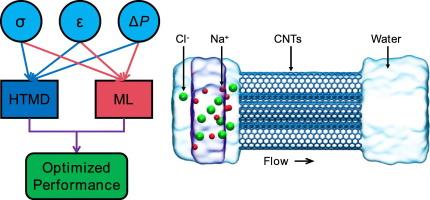通过高通量分子动力学模拟和机器学习分析优化膜法海水淡化性能
IF 8.3
1区 工程技术
Q1 ENGINEERING, CHEMICAL
引用次数: 0
摘要
孔径和亲水性对反渗透膜渗透性的影响一直是关注的焦点。然而,由于这两种因素会相互干扰,因此很难明确它们的影响。在这项工作中,使用 CNT 进行高通量分子动力学(HTMD)模拟,广泛生成了透水性和 NaCl 排阻数据。然后通过机器学习(ML)方法对这些数据进行分析,以获得优化的海水淡化性能。HTMD 结果表明,压降对透水量的影响很小。此外,增加孔径和降低亲水性通常会提高透水性,但会在一定程度上牺牲 NaCl 的去除率。本研究还发现了孔径和亲水性之间的干扰效应,并从分子层面揭示了其机理。此外,还应用了 ML 分析透水性和 NaCl 阻隔性的大量数据。确定了实现最高透水率和 100% NaCl 阻隔率的最佳条件,并通过额外的 MD 模拟进行了验证。这项工作表明,HTMD 和 ML 的整合有望在未来设计出性能更佳的新型反渗透膜。本文章由计算机程序翻译,如有差异,请以英文原文为准。

Optimized performance of membrane-based desalination by high-throughput molecular dynamic simulations and machine learning analysis
The influence of pore size and hydrophilicity on the permeance of reverse osmosis (RO) membranes has been mostly focused. However, their influence is hardly to be clearly identified as these two kinds of factor interfere with each other. In this work, high-throughput molecular dynamics (HTMD) simulations with CNTs are used to extensively produce the data of water permeance and NaCl rejection. These data are then analyzed by machine learning (ML) method to obtain the optimized desalination performance. The HTMD results indicate that the pressure drop has little effect on the water permeance. Moreover, rising pore size and degrading hydrophilicity will generally boost water permeance but will somehow sacrifice the NaCl rejection. The interference effect between pore size and hydrophilicity is also found in this work, the mechanism of which is then revealed from molecular level. Additionally, ML is applied to analyze the abundant data of water permeance and NaCl rejection. The optimal conditions are identified to achieve the highest water permeance with 100% NaCl rejection, which are also validated via additional MD simulations. This work suggests that the integration of HTMD and ML promises the future of designing new kind of RO membranes for better performance.
求助全文
通过发布文献求助,成功后即可免费获取论文全文。
去求助
来源期刊

Desalination
工程技术-工程:化工
CiteScore
14.60
自引率
20.20%
发文量
619
审稿时长
41 days
期刊介绍:
Desalination is a scholarly journal that focuses on the field of desalination materials, processes, and associated technologies. It encompasses a wide range of disciplines and aims to publish exceptional papers in this area.
The journal invites submissions that explicitly revolve around water desalting and its applications to various sources such as seawater, groundwater, and wastewater. It particularly encourages research on diverse desalination methods including thermal, membrane, sorption, and hybrid processes.
By providing a platform for innovative studies, Desalination aims to advance the understanding and development of desalination technologies, promoting sustainable solutions for water scarcity challenges.
 求助内容:
求助内容: 应助结果提醒方式:
应助结果提醒方式:


